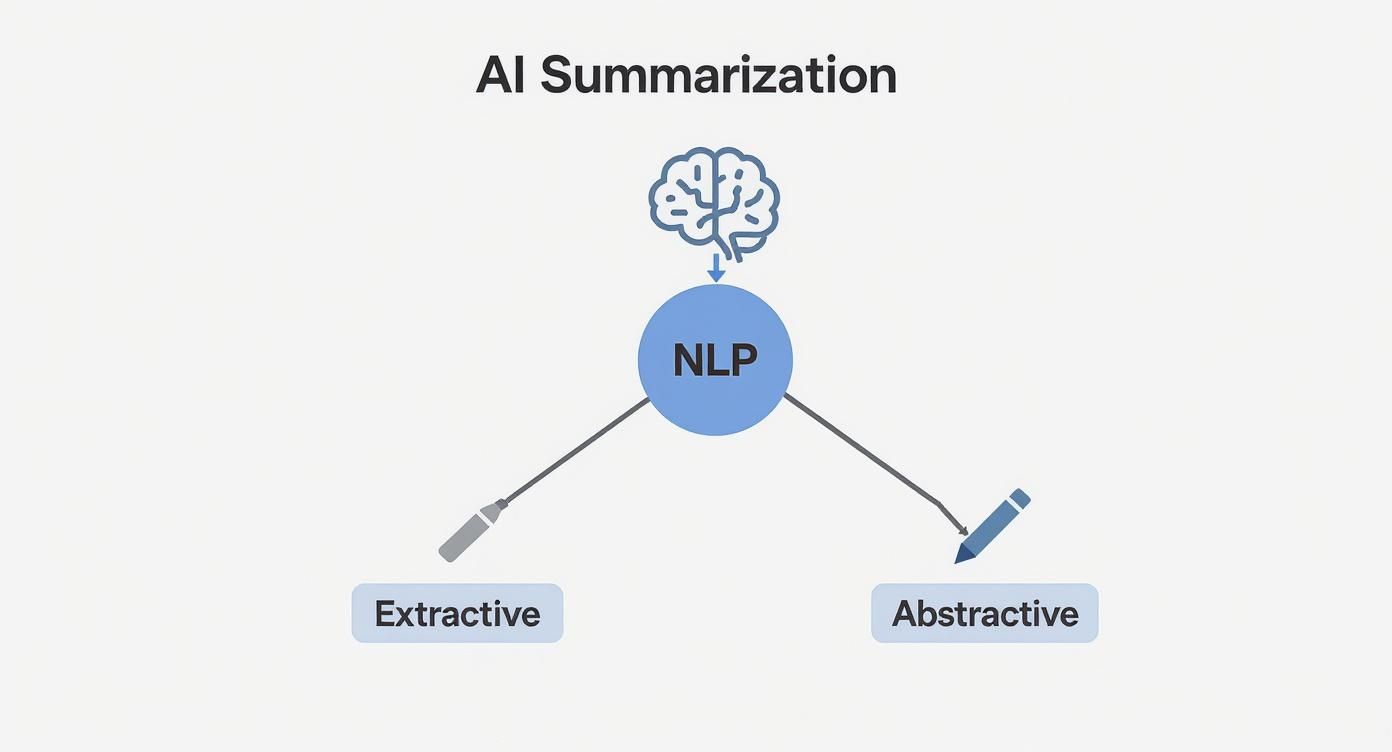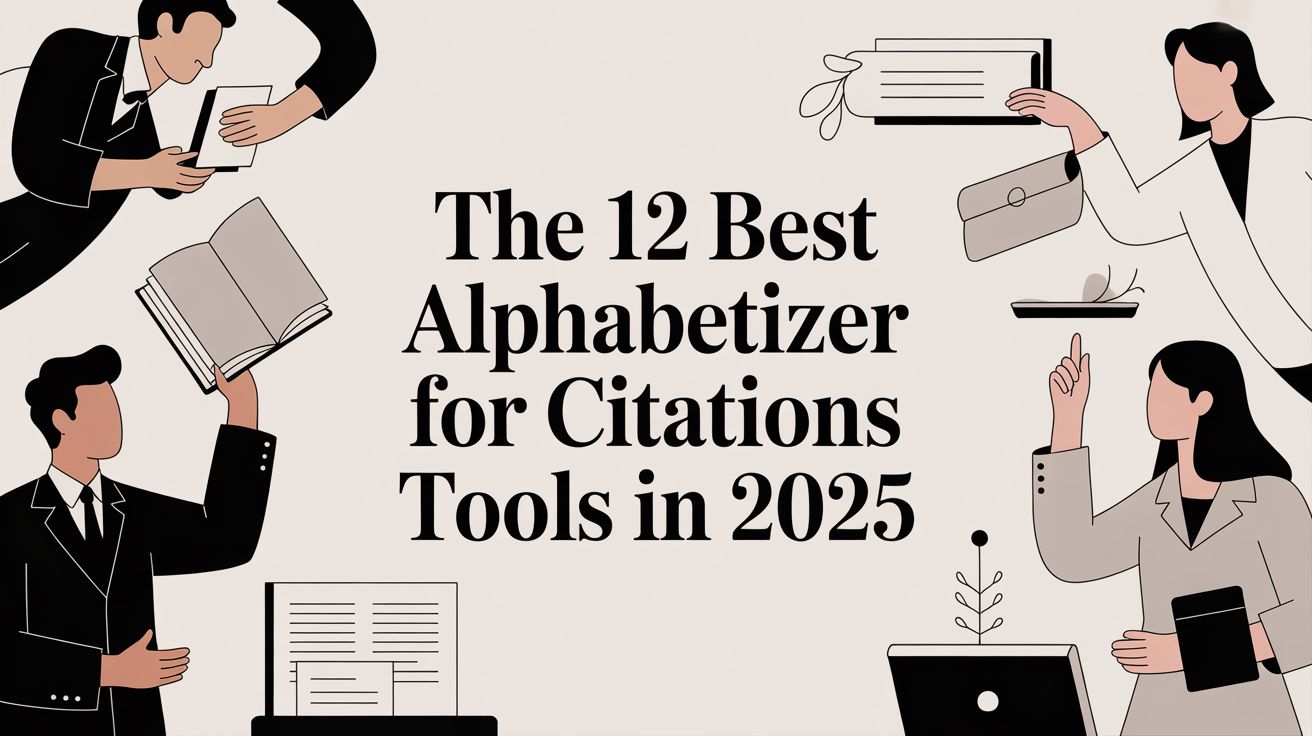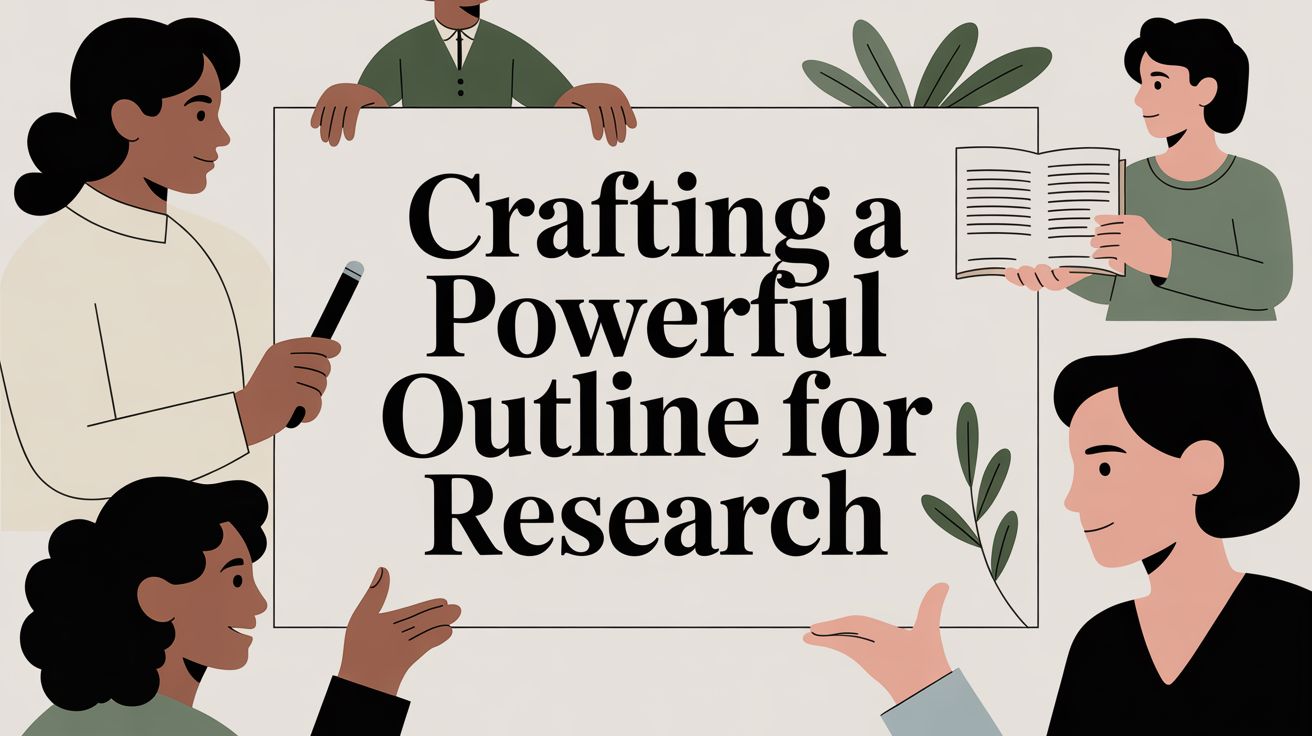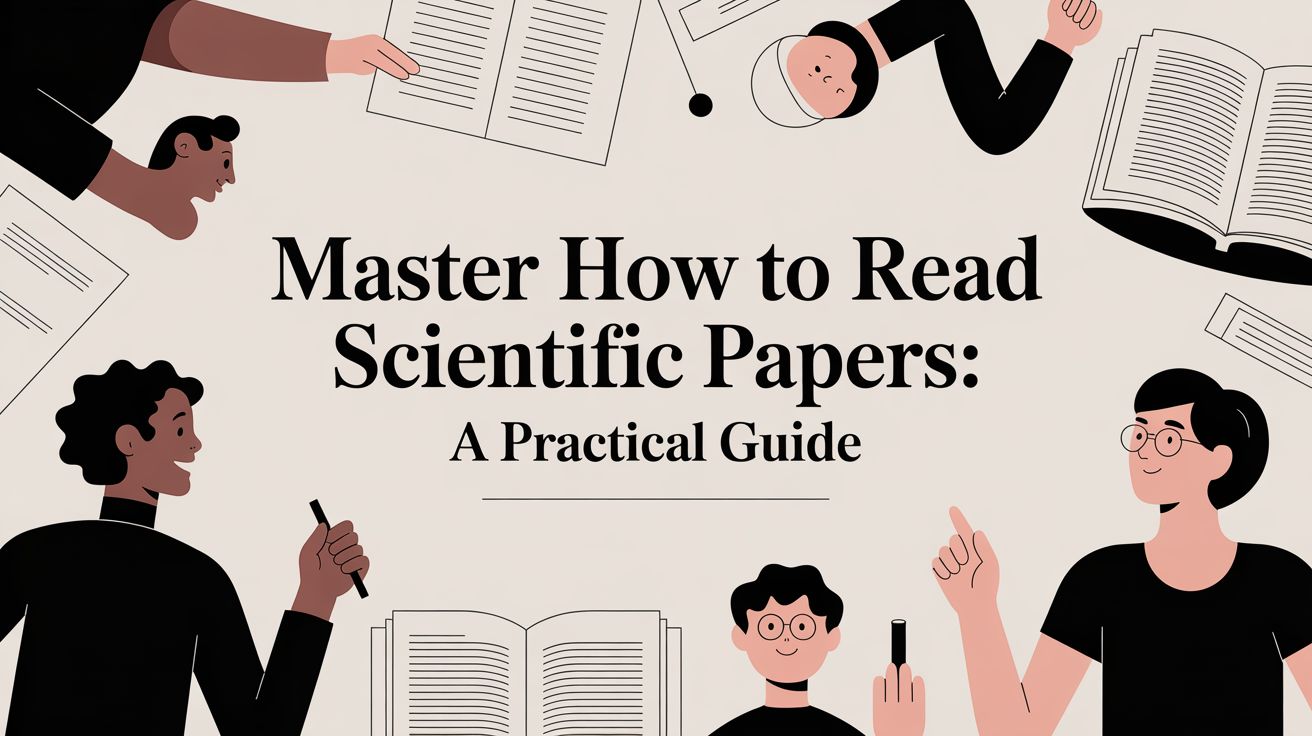Your Guide to a Research Paper Summarizer
Discover how a research paper summarizer uses AI to distill key insights from dense texts. Learn how these tools work and how to use them effectively.

A research paper summarizer is an AI tool designed to take long, complex academic papers and boil them down into short, easy-to-understand summaries. It’s built to spot the most important parts—like the core arguments, methods, findings, and conclusions—and present them to you in a fraction of the time it would take to read the whole thing. Think of it as your personal research assistant, saving you countless hours of reading.
Tired of Drowning in Academic Papers?

If you're a student or professional, you know the feeling of staring at a seemingly endless pile of research papers. The pressure to keep up is real. In fact, some studies show that researchers read around 250 papers per year, spending roughly 45 minutes on each one. That workload can get overwhelming, fast.
Every paper is a maze of dense terminology, complicated data, and subtle arguments that take real mental effort to sort through. It can feel like your entire job is just getting through the reading list, which doesn't leave much time for the actual work of thinking, analyzing, and forming your own ideas.
Your Expert Research Assistant
This is where a research paper summarizer completely changes the dynamic. It's not meant to replace reading altogether, but to act as a powerful filter. Imagine having a brilliant assistant who skims a 50-page document for you and hands back a one-page brief with just the highlights.
This lets you quickly gauge whether a paper is even relevant to your work. Instead of investing a full hour only to realize a study is a dead end, you can get the main points in just a few minutes and decide if it's worth a closer look. It’s all about working smarter.
An effective summarizer cuts through academic jargon to save you hours, letting you focus on analysis and insight rather than the tedious task of preliminary reading.
By handling the initial screening, these tools free up your mental bandwidth for more important tasks. They help you zero in on the most essential studies, pull out the key concepts, and get a solid grasp of a topic with incredible speed. For anyone managing a heavy research load, that efficiency is a lifesaver. A good summarizer points you straight to the parts that matter most.
How AI Actually Summarizes a Research Paper
So, how does an AI take a dense, 20-page research paper and distill it into a handful of key points? The magic behind it all is a technology called Natural Language Processing (NLP).
Think of NLP as the bridge that allows a computer to read, understand, and interpret human language. It’s not just about recognizing words on a page; it’s about grasping context, identifying relationships between concepts, and figuring out what’s truly important. To really get a handle on this, it's worth understanding the Natural Language Processing (NLP) basics that make these tools possible.
The demand for this kind of smart technology is exploding. The global market, valued at $226.8 million in 2024, is expected to skyrocket to $1,886.7 million by 2030. That growth is fueled by two main approaches to summarization.
Extractive Summarization: The Smart Highlighter
The first method is called extractive summarization. The best way to picture this is to imagine you're reading a textbook with a highlighter. You aren't writing new sentences; you're simply picking out the most critical ones that contain the core ideas.
That's exactly what an extractive AI does. It scans the paper, scores each sentence based on things like keyword frequency and where it appears in the text, and then pulls out the highest-scoring sentences to create the summary. The beauty of this method is that it uses the author’s original words, so you know you're getting the information straight from the source.
- How it works: It identifies and literally extracts key sentences from the document.
- Key benefit: High factual accuracy because nothing is rephrased or interpreted.
- Best for: When you need to quickly pull out the main arguments and data without any fluff.
This approach is fast and reliable for getting the raw facts. The only downside is that the resulting summary can sometimes feel a bit choppy, like a list of quotes instead of a seamless paragraph.
Extractive summarization is like creating a highlight reel of a research paper. It shows you the most important moments directly from the source, but it doesn't add any new commentary.
Abstractive Summarization: The Skilled Interpreter
The second, more sophisticated method is abstractive summarization. If extractive summarization is a highlighter, then abstractive summarization is like asking a knowledgeable colleague to read the paper and then explain it to you in their own words.
Instead of just copying and pasting, the AI uses deep learning models to truly comprehend the material. It digests the arguments, methodology, and findings, then generates a completely new, human-sounding summary. This is what produces those smooth, coherent paragraphs that capture the essence of the research without just repeating it.
Most of the best tools today actually use a hybrid approach, blending the precision of extractive methods with the readability of abstractive ones to give you the best of both worlds.
Features That Define The Best Summarizers
Not all research paper summarizers are created equal. While plenty of tools can spit out a basic summary, the really good ones act more like a research assistant—a partner equipped with features designed to speed up your work and genuinely deepen your understanding. Knowing what to look for is the key to picking a tool that will actually make a difference.
At the very heart of it all, high accuracy and coherence are non-negotiable. A great summarizer doesn’t just yank random sentences from the text. It needs to understand the paper's structure, pinpoint the core arguments, and then present them in a logical way that’s easy to follow. The summary should flow naturally and, crucially, preserve the original author's intent without twisting tentative findings into hard facts.
This is all powered by Natural Language Processing (NLP), the "brain" that drives the two main summarization methods: extractive and abstractive.

As the diagram shows, a truly sophisticated tool has to blend both approaches. It must be smart enough to extract the critical facts while also being able to rephrase complex ideas for clarity, giving you the best of both worlds.
Essential Capabilities For Modern Research
Moving beyond a simple summary, a few key features separate the gadgets from the truly indispensable academic tools. These are the capabilities that tackle the real-world headaches of doing thorough research, making the entire process smoother from discovery to writing.
One of the most valuable features you can find is automatic citation generation and verification. The best summarizers don't just throw information at you; they show you exactly where it came from in the original document.
A top-tier summarizer provides clickable citations that link every part of the summary back to the specific page and paragraph in the source PDF. This feature is vital for quick fact-checking and maintaining academic integrity.
This completely removes the guesswork and saves you from the tedious, time-sucking task of hunting down sources. You can instantly verify a critical statistic or a key finding, ensuring your own work is built on a rock-solid foundation.
Advanced Features That Power Deeper Insights
Today's top tools have moved far beyond summarizing just one document at a time. They now offer advanced functions that help you connect the dots across your entire research library, completely changing how you tackle big projects like literature reviews.
Multi-Language Support: For anyone working with international literature, the ability to summarize papers in multiple languages is a huge advantage. The best tools can take a paper written in German, for instance, and give you a perfectly coherent summary in English, breaking down language barriers.
Cross-Document Analysis: This is arguably one of the most powerful features available. It lets you upload a whole batch of papers and ask questions across all of them at once. Imagine asking, "What are the common limitations cited in these 15 studies?" and getting a single, synthesized answer that pulls information from each relevant paper.
Interactive Q&A: Instead of just getting a static, one-and-done summary, you can actually "chat" with your documents. This lets you ask follow-up questions, get clarification on a complicated methodology, or find a specific data point without having to skim through hundreds of pages again.
To find the right fit, it's always a good idea to compare various AI solutions like Mindsmith AI and see how their feature sets stack up for your specific needs.
Here’s a quick breakdown of the essential features to look for in a modern summarizer and why they're so important.
Essential Features in a Modern Research Paper Summarizer
| Feature | Why It Matters | Ideal for |
|---|---|---|
| High-Accuracy Summaries | Prevents misinterpretation of complex findings and ensures the summary is a reliable reflection of the original work. | Everyone, from students to senior researchers. |
| Clickable Citations | Provides instant verification by linking summary points directly to the source text, saving hours of fact-checking. | Writing literature reviews, dissertations, and grant proposals. |
| Cross-Document Q&A | Allows you to ask a single question across multiple papers to synthesize themes, compare methodologies, or identify gaps. | Researchers conducting large-scale reviews or looking for novel connections. |
| Multi-Language Support | Breaks down language barriers, opening up access to a wider body of global research. | Academics in international fields or anyone working with non-English sources. |
| Interactive Chat | Turns passive reading into an active dialogue, letting you probe deeper into the text with specific follow-up questions. | Students trying to grasp complex topics and researchers needing quick answers. |
Ultimately, a great tool complements your own critical thinking skills. Understanding the link between summarizing and active reading is the first step. For more on this, check out our guide on the vital role of summarizing in reading comprehension. When you choose a tool with these robust features, you’re not just getting summaries; you’re investing in a smarter, faster, and more insightful research process.
A Step-by-Step Research Workflow

It’s one thing to talk about features, but it’s another to see how they actually fit into your day-to-day work. Let's walk through a classic academic chore—the literature review—and see how a research paper summarizer can completely change the game. This isn't about skipping steps; it's about making each one smarter.
First things first: gathering your sources. Instead of juggling a chaotic mess of browser tabs and downloaded files, you start by uploading all the papers you've found right into the tool. This instantly creates a single, organized library for your entire project. Everything is in one place before you even begin.
With your documents loaded, the real magic starts to happen.
Phase 1: Initial Screening and Filtering
Now that your papers are collected, you can get an instant summary for every single one. We’re not talking about a deep, nuanced reading at this stage. This is all about speed and efficiency. In a matter of minutes, you can have the abstract, core arguments, and main conclusions for every PDF in your library.
This lets you immediately start weeding out the papers that aren't relevant. You know the feeling—a title sounds perfect, but the actual study is way off track. A quick summary reveals that in seconds, saving you from wasting an hour reading the whole thing. It’s like a high-speed triage for your reading list.
A research paper summarizer acts as your first line of defense against irrelevant literature. It helps you rapidly build a curated list of high-impact papers, saving you from hours of unproductive reading.
Think of it this way: you’re essentially pulling out the vital signs of each paper—its objectives, methods, and key findings. There are a few ways to do this, from narrative summaries that retell the story of the paper to a précis that surgically removes fluff to preserve the core logic.
Phase 2: Deep Dive and Synthesis
Once you’ve narrowed your stack down to the most promising papers, it’s time to go deeper. This is where advanced features like cross-document Q&A become your secret weapon. Instead of treating each paper as an island, you can start asking questions that span your entire collection.
For instance, you could pose a question like, “What are the common methodologies used to study X?” The tool will then dig through all of your uploaded documents and pull together a single, coherent answer. Better yet, it will provide citations, showing you exactly which paper contributed each piece of information.
This approach is fantastic for spotting trends, finding contradictions between studies, and identifying gaps in the existing research—all without needing to manually cross-reference a dozen different documents. You shift from just consuming information to actively connecting the dots between sources. Our guide on how to effectively read scientific papers has more strategies that work beautifully with this process.
When you're ready, you can export all these insights, synthesized answers, and formatted citations straight into your writing software. But here’s a pro-tip I can’t stress enough: always treat the summary as your map, not the destination. Before you cite anything, click through to the original source to double-check the data and grasp the full context. It's a critical final step for maintaining academic integrity.
Comparing AI Summarizers to Traditional Methods
https://www.youtube.com/embed/OaEw7ZFs5sU
To really get why a modern research paper summarizer is such a game-changer, it helps to see how it stacks up against the old-school methods researchers have been using for decades. There's a big difference in the rhythm and results, from the slow, methodical pace of doing it all by hand to the sheer speed of AI.
The most traditional method is, of course, just manual summarization. You read the paper from start to finish, take pages of notes, and then try to boil it all down to the core ideas yourself. This is fantastic for deeply understanding a single paper, but its Achilles' heel is the time it eats up. When you're staring down a deadline with a mountain of literature to get through, this manual approach becomes a serious bottleneck.
Exploring Other Common Alternatives
Before AI tools were on every researcher's laptop, people found other ways to get through material faster. These methods still have their uses, but each has certain trade-offs that AI summarizers are built to solve.
Abstract Databases (PubMed, Google Scholar): Great for the initial search. An abstract gives you the author's own quick-and-dirty version of their study. The problem is, abstracts are designed to be brief and often leave out crucial details on methodology, limitations, or nuance that are buried deep inside the full text.
Hiring Human Research Assistants: If you have the funding, this is the gold standard. A good assistant can give you incredibly detailed and thoughtful summaries. The obvious catch is the cost, which puts this option out of reach for most students, independent researchers, and smaller labs.
The need for better ways to process information is undeniable. Just look at the global market research services sector—an industry that lives and breathes data analysis—which was valued at USD 93.37 billion in 2025 and is still growing. You can dig into the numbers in the complete market research services report.
AI summarizers strike a unique balance. They offer the speed of skimming an abstract but with the depth of a more thorough reading, all at a fraction of the cost of hiring help.
The Clear Advantage of AI Integration
A research paper summarizer fits perfectly into the middle ground. It handles the most time-consuming parts of manual work but gives you way more substance than a simple abstract ever could. In a way, it makes the kind of high-level support once reserved for big-budget projects available to everyone.
By combining speed, depth, and accessibility, these AI tools offer a much more practical workflow for how research gets done today. They let you quickly triage a pile of papers, pinpoint the ones that matter most, and save your valuable time for the real work: thinking, analyzing, and connecting the dots.
Common Questions About Research Summarizers
Diving into AI-powered research tools is bound to bring up a few questions. That's completely normal. When your academic or professional work is on the line, you need to be sure the tools you're using are effective, reliable, and ethical. Let's tackle some of the most common concerns people have so you can start using a research paper summarizer with total confidence.
Getting clear answers on everything from accuracy to academic integrity is the best way to start working smarter, not just harder.
Are AI Summaries Accurate Enough for Academic Work?
This is usually the first question on everyone's mind, and for good reason. The short answer is yes—modern AI summarizers are surprisingly good at pulling out the core arguments, methods, and key findings of a paper. They are fantastic for getting a quick, high-level grasp of a study you've just found.
But here’s the key: think of an AI summary as a first-pass tool. It's like having an expert assistant who reads ahead and highlights the most important parts for you. If you're pulling a specific statistic, a critical piece of data, or a direct quote for your own work, you should always click back to the original source to double-check the context. The summary is a highly intelligent guide, but it's not a substitute for your own critical judgment.
The real magic of an AI summary isn't that it replaces reading, but that it makes your reading exponentially faster. It points you straight to the sections that matter most, letting you vet them yourself. It’s the perfect blend of speed and scholarly rigor.
Is Using a Summarizer Considered Plagiarism?
In a word, no. Using a research paper summarizer to help you understand a source is not plagiarism. Plagiarism is when you pass off someone else's work or ideas as your own. A summarizer is a learning aid; it helps you digest complex information more quickly, but you're not claiming you wrote the summary or the original paper.
Your responsibility to cite your sources properly doesn't change one bit. In fact, the best tools actually make this easier. They provide precise, clickable citations that take you right back to the source text, so you know exactly where the information came from. The AI helps your comprehension, but citing the original paper is how you maintain your academic integrity. For a deeper look at this, our guide explains more about how to summarize a research paper the right way.
Can These Tools Handle Papers in Other Languages?
Absolutely, and this is a game-changer for anyone doing global research. Many of the top summarizers now come with robust multi-language support.
- Processing: They can take in and analyze articles written in dozens of different languages.
- Summarization: The tool can then create a perfectly coherent summary of that non-English paper.
- Translation: In many cases, you can get that summary translated directly into English, instantly breaking down language barriers that once would have stopped you in your tracks.
This capability opens up a whole new world of literature for your review. Suddenly, you can incorporate international perspectives that might have been completely inaccessible before. Just be sure to check which languages a specific tool supports to make sure it fits your needs.
How Do Summarizers Handle Multiple Articles at Once?
This is where the truly advanced tools stand out. They move beyond just summarizing one document at a time and become real analytical partners. The best summarizers have features for multi-document analysis, which completely changes how you approach a literature review.
Imagine uploading an entire folder of related papers and asking a single question across all of them. For instance, you could ask, "What are the common limitations cited across these studies on renewable energy?" The AI will then scan every single PDF and synthesize one cohesive answer.
It pulls the relevant information from each source and presents it to you with citations pointing back to the exact paper where it found the information. This elevates the tool from a simple summarizer to a genuine research assistant that can spot trends, compare methodologies, and uncover connections across your entire library.
Ready to see what this looks like in practice? PDF Summarizer offers all these features and more, turning dense research into clear, actionable knowledge. Get instant summaries, ask questions across all your documents, and verify every fact with clickable citations. Try it now for free at https://pdfsummarizer.pro.
Relevant articles
Discover the best AI tools for academic research. Our curated list covers literature reviews, data extraction, writing, and summarization to speed up your work.
Discover how to conduct a literature review with a practical, step-by-step guide covering scope, synthesis, and reporting findings.
Discover the top 12 tools to streamline your writing. Find the perfect alphabetizer for citations to create flawless reference lists effortlessly.
Learn how to create a powerful outline for research that streamlines your writing process. Get practical tips and examples for any academic paper or thesis.
How to read scientific papers: Learn planning, annotation, and critical appraisal to extract actionable insights and improve your research outcomes.
Learn how to summarize a research paper with clear guidance on reading tactics, note taking, concise abstracts, tools, and common pitfalls.





